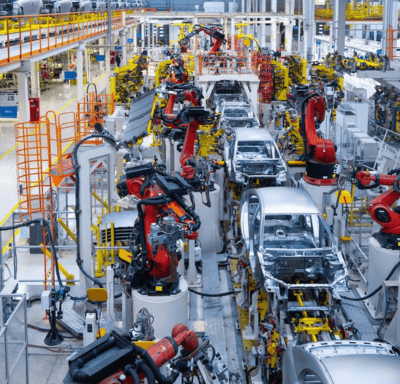
About us
Our Services
Our Expertise
Our Experience
Follow us
Why e2logy?
- We strive to provide superior customer service and ensure that every client is completely satisfied with our work.
- Our engineers are trustworthy, dedicated, and experienced and will go the extra mile to solve your IT issues.
- We are committed to delivering outstanding, cutting-edge IT solutions that add real value that goes beyond what is expected.

How Artificial Intelligence And Machine Learning are used In Manufacturing

In the industrial sector, artificial intelligence (AI) and machine learning (ML) are transforming the market. No exception is made when it comes to manufacturing. By designing a smart factory, you can improve product design and production efficiency, be more competitive, and optimize timelines. This technology can contribute to the redesign of a highly productive, safer, and more sustainable manufacturing process through quality, worker safety, and sustainability.
To remain competitive, manufacturing companies must find new applications and understand market trends. By seeking leadership, it will be easier to comply with industry regulations and standards, improve safety, and minimize environmental impact.
How does AI differ from machine learning?
Most manufacturers want to incorporate these technologies into their processes, so this is their general question. It’s time to resolve that issue.
What is artificial intelligence?
A computer system that simulates real-life cognitive functions such as learning and problem-solving is called artificial intelligence (AI). By using mathematical and logical algorithms, an AI program simulates the way people make decisions and acquire new data.
Benefits of AI in manufacturing
AI has many benefits for the manufacturing industry, but what are the most significant ones? Ninety-three percent of business leaders in industrial manufacturing report that their company uses AI at least somewhat. Here are some reasons:
- Automation that is directed: As AI and robots revolutionize mass production, they are mainly utilized in industrial manufacturing. In addition to performing recurring functions, robots are also capable of designing production models, raising competence, automating tasks, eradicating human errors, and providing superior quality assurance services.
- Enhance quality: Manufacturing may benefit most from artificial intelligence in terms of quality assurance. A machine learning model can help businesses detect deviations from expected design criteria, flaws, and consistency issues that a human would miss. In addition to improving product quality, machine learning techniques reduce quality assurance costs and time.
- Smart maintenance: Predictive maintenance helps save the company an enormous amount of money, which is why it is such a vital solution.A complex algorithm like neural networks or machine learning is used to predict the status of assets and machines. A significant increase in the Remaining Useful Life (RUL) is experienced by equipment. An experienced technician will know exactly what needs to be fixed and even what method to use.
- A 24×7 production service: The production line is manned by humans working 3 shifts to ensure continuous production, but robots can work 24/7. In recent years, businesses have expanded their production capabilities and met the high demand of customers across the globe.
- Development of AI-based products: With AI-powered product development, producers can test multiple models of a product in AR and VR before beginning production. Simplify the process of maintaining and fixing bugs. A new wave of progressive products, which hit the market ahead of the competition, may be created by manufacturers using AI-based product creation.
- Adaptation to the market: Factory 4.0 already includes AI and machine learning, but it can also improve supply chains by making them more responsive to market changes. Managers can therefore benefit from AI suggestions by improving their strategic vision. By combining the status of the economy, weather, consumer behaviour, and political situations, AI generates estimates. Predictions can be used to calculate the number of employees, inventory, and materials supply. Artificial Intelligence and Machine Learning are already being used by the biggest companies around the globe in manufacturing, and millions are being invested in their development.
- Cost-savings: AI in manufacturing is viewed with apprehension by many businesses because of the significant capital commitment required. Over time, the ROI becomes more significant. With intelligent machines taking over factory tasks, businesses will experience significant savings, as well as predictive maintenance reducing downtime for machines. In addition, consumers are looking for distinctive, customized, or personalized products that offer the best value. With advancements in technology such as 3D printing and IIoT-connected devices, addressing these needs has become easier and less expensive. It implies that production costs will be lower if virtual or augmented reality design approaches are adopted. The cost of manual machine testing can be reduced due to automated machine learning and CAD integration, which permits the creation and testing of systems before they go into production.
- A new era of human potential: By automating boring and ordinary tasks in manufacturing plants, AI will free workers to focus on more complex and innovative work. Humans can focus on innovating and driving business forward while AI takes care of unskilled labour.
What is machine learning?
AI in practice is referred to as “machine learning.” Machine learning is a method of acquiring knowledge without being explicitly programmed by a programmer. The computer can do this by learning from its past experiences and improving itself.
Benefits of machine learning in manufacturing
Machine learning can significantly enhance manufacturers’ production operations with multiple use cases. Machine learning provides the following benefits:
- An improved supply chain management system: Manufacturers ensure that their factories have adequate materials by deploying machine learning appropriately. By completing and delivering orders on time, customer satisfaction is improved.
- Control of quality: Product inspection and quality control are also carried out using machine learning models. Learning from historical data can automate inspection and supervision processes by distinguishing good products from faulty ones using machine learning algorithms. A library of possible defects isn’t necessary with these algorithms because they only require good samples for their training set. The most common types of defects can, however, be compared using an algorithm. Visual quality control in manufacturing can be significantly reduced with machine learning.
- Manage your data better: According to the International Data Corporation (IDC), by 2024 there will be 143 zettabytes of data in the world totalling more than 142 trillion bits. Putting this into context, a zettabyte would be equivalent to a trillion gigabytes or a billion terabytes. Factory data is a valuable resource in modern manufacturing. Smart data can be effectively used in maintenance management, for example. In addition to providing automated, precise information on failure modes and frequencies, maintenance automation can also determine the proper maintenance schedule for the equipment. Moreover, it can assist in identifying ‘downtime culprits,’ which are often human-related. By preventing sudden breakdowns and expensive shutdowns, inventory and asset management are optimized, resulting in cost savings.
- Product development: It has been widely adopted in the product development phase that machine learning is widely used. To generate the best results, new products are designed and planned with a multitude of factors in mind, as well as improving existing ones. In this way, ML solutions can help collect consumer data and analyse it to discover hidden needs, uncover new business opportunities, and understand consumer demands. Eventually, the company ends up with better products, as well as new ones, which can contribute to increased revenue. As machine learning provides insights that enable better planning, it reduces the risk associated with developing new products
- Cost-effective production: Lower production costs can be achieved by implementing machine learning earlier in the process. Due to the reduced need for machinery repair, utility bills, and space utilization, the business can cut costs.
- Inventory Management and Logistics: To run the entire production process, manufacturing industries require extensive logistics capabilities. Many logistics-related tasks can be automated with machine learning solutions, boosting efficiency and lowering costs. With DeepMind AI, Google was able to reduce its data centre cooling bill by 40% by using machine learning algorithms.
- Make your data more secure: As there is so much data within production facilities, it, therefore, necessitates that data security is improved. A Zero Trust Security (ZTS) framework can greatly enhance data security by using machine learning. The ZTS data security model is based on the principles of ‘never trust, always verify, enforce the lowest privilege’. Both inside and outside the network are protected by this rigid, uncompromising approach to data security. A heightened level of data security is enabled by machine learning. Computer models observe and analyse all data-related activities of individual users, including sensitive business information, to achieve this goal.
- Robots: There is still a heavy reliance on human labour in modern manufacturing. Although automation is rising in manufacturing, many tasks are now capable of being performed by robots, except for a few that require extreme precision that can only be performed by humans. There is a possibility that robots that are flexible enough to work with humans will take over a large portion of manufacturing in the future. With minimal human supervision, they can operate in diverse and dynamic environments. As a result of robotics, manufacturers can develop complex manufacturing processes and strategies using advanced machine-learning techniques.
Artificial Intelligence (AI) and Machine Learning (ML) in Manufacturing
In the production and supply chain, there is a trend to solve the problems that have plagued the industrial sector for decades. To generate sustainable and profitable solutions, it is vital to analyse and monitor in real time. The ability to visualize the process at all times makes it possible to avoid bottlenecks in production chains. The cost of downtime, emergency, and last-minute failures is no longer an issue. With preventative maintenance, repairs can be predicted and made quickly. An information-driven process revolution brings these benefits.
Conclusion
AI and machine learning have many potential benefits for the manufacturing industry, as you can see. As a result of these technologies, manufacturing can be revolutionized and products can be produced more efficiently.
It will, however, take time for them to become widely adopted due to several challenges. Although AI and machine learning are not yet widely used in manufacturing, there is an encouraging future. Businesses need to find the right AI technology stack, tools, and digital partners to help them integrate AI seamlessly.













